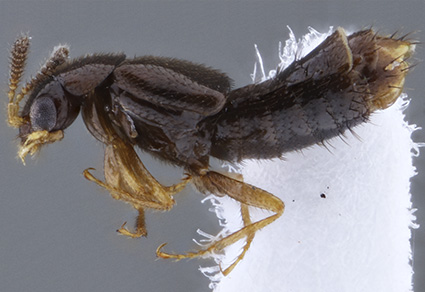Abstract
Microlia Casey is a genus of small rove beetles from the New World and Australasia. Many species are recorded to be associated with the flowers of Cucurbitaceae, Solanaceae, Asteraceae, and Monimiaceae. In this work, a new species from Brazil associated with flowers of Cayaponia (Cucurbitaceae), Microlia cayaponia Zilberman & Pires-Silva sp. nov., is described and illustrated. Aspects of its natural history are also investigated, with insights on foraging, reproduction, and the supposed impact on the plant and pollinator’s fitness.
References
- Alves-Dos-Santos, I., Da Silva, C.I., Pinheiro, M. & De Matos Peixoto Kleinert, A. (2016) Artigo de Opinião / Point of View Paper: Quando um visitante floral é um polinizador? Rodriguesia, 67, 295–307. https://doi.org/10.1590/2175-7860201667202
- Assunção, M.A., Torezan-Silingardi, H.M. & Del-Claro, K. (2014) Do ant visitors to extrafloral nectaries of plants repel pollinators and cause an indirect cost of mutualism? Flora—Morphology, Distribution, Functional Ecology of Plants, 209, 244–249. https://doi.org/10.1016/j.flora.2014.03.003
- Barônio, G.J., de Brito, V.L.G., Nogueira, A. & Rech, A.R. (2020) Beyond robbery: the role of upside-down behaviour performed by small oil-collecting bees in Malpighiaceae. Arthropod Plant Interact, 14, 613–621. https://doi.org/10.1007/s11829-020-09770-9
- Barônio, G.J., Guimarães, B.M. da C., Oliveira, L.C. de, Melo, L.R.F., Antunes, P.R., Cardoso, R.K.D.O.A. & Araújo, T.N. (2018) Entre Flores E Visitantes: Estratégias de Disponibilização e Coleta de Recursos Florais. Oecologia Australis, 22, 390–409. https://doi.org/10.4257/oeco.2018.2204.04
- Barth, O.M., Pinto Da Luz, C.F., Gomes-Klein V.L. & Gomes-Klein, V.L. (2005) Pollen morphology of Brazilian species of Cayaponia Silva Manso (Cucurbitaceae, Cucurbiteae). Grana, 44, 129–136. https://doi.org/10.1080/00173130510010486
- Bortoluzzi, S., Caron, E. & Silveira, D. (2016) Two new species of Microlia Casey (Coleoptera: Staphylinidae) with comments on obligatory pollen-feeders and the first record from South America. Zootaxa, 4078 (1), 197–208. https://doi.org/10.11646/zootaxa.4078.1.18
- Briscoe, A.D. & Chittka, L. (2001) The Evolution of Color Vision in Insects. Annual Review of Entomology, 471–510
- Cameron, M. (1943) New Species of Staphylinidæ (Col.) from Australia and New Guinea. Journal of Natural History, 10 (65), 336–354.
- Cembrowski, A.R., Tan, M.G., Thomson, J.D. & Frederickson, M.E. (2014) Ants and ant scent reduce bumblebee pollination of artificial flowers. The American Naturalist, 183, 133–139. https://doi.org/10.1086/674101
- Cordeiro, G.D., Pinheiro, M., Dötterl, S. & Alves-dos-Santos, I. (2017) Pollination of Campomanesia phaea (Myrtaceae) by night-active bees: a new nocturnal pollination system mediated by floral scent. Plant Biology, 19, 132–139. https://doi.org/10.1111/plb.12520
- Duchen, P. & Renner, S.S. (2010) The evolution of Cayaponia (Cucurbitaceae): Repeated shifts from bat to bee pollination and long-distance dispersal to Africa 2-5 million years ago. American Journal of Botany, 97, 1129–1141. https://doi.org/10.3732/ajb.0900385
- Gomes-Klein, V.L. & Pirani, J.R. (2005) Four new species of Cayaponia (Cucurbitaceae) from Brazil and Bolivia. Brittonia, 57, 108–117. https://doi.org/10.1663/0007-196X(2005)057[0108:FNSOCC]2.0.CO;2
- Gonçalves-Souza, T., Omena, P.M., Souza, J.C. & Romero, G.Q. (2008) Trait-mediated effects on flowers: Artificial spiders deceive pollinators and decrease plant fitness. Ecology, 89, 2407–2413. https://doi.org/10.1890/07-1881.1
- Gonzálvez, F.G., Santamaría, L., Corlett, R.T. & Rodríguez-Gironés, M.A. (2013) Flowers attract weaver ants that deter less effective pollinators. Journal of Ecology, 101, 78–85. https://doi.org/10.1111/1365-2745.12006
- Gusarov, V.I. (2002) A revision of the genus Microlia Casey, 1910 (Coleoptera: Staphy-linidae: Aleocharinae: Hoplandriini). Zootaxa, 34 (1), 1–24. https://doi.org/10.11646/zootaxa.34.1.1
- Hanley, R.S. (2003) Generic revision of the staphylinid beetle tribe Hoplandriini (Insecta: Coleoptera: Staphylinidae: Aleocharinae). Zoological Journal of the Linnean Society, 138, 83–140. https://doi.org/10.1046/j.1096-3642.2003.00060.x
- Lea, A.M. (1910) On Australian and Tasmanian Coleoptera, with descriptions of new species. Part I. Proceedings of the Royal Society of Victoria, 22 (1909), 113–152.
- Lea, A.M. (1912) Australian and Tasmanian Coleoptera Inhabitiny or Resorting to the Nests of Ants, Bees and Ter. Proceedings of the Royal Society of Victoria, 25, 31.
- Ollerton, J., Winfree, R. & Tarrant, S. (2011) How many flowering plants are pollinated by animals? Oikos, 120, 321–326. https://doi.org/10.1111/j.1600-0706.2010.18644.x
- Schweiger, O., Biesmeijer, J.C., Bommarco, R., Hickler, T., Hulme, P. E., Klotz, S., Kühn, I., Moora, M., Nielsen, A., Ohlemüller, R., Petanidou, T., Potts, S.G., Pyšek, P., Stout, J. C., Sykes, M.T., Tscheulin, T., Vilà, M., Walther, G.-R., Westphal, C., Winter, M., Zobel, M. & Settele, J. (2010) Multiple stressors on biotic interactions: How climate change and alien species interact to affect pollination. Biological Reviews, 85, 1129–1141. https://doi.org/10.3732/ajb.0900385
- Wcislo, W.T., Arneson, L., Roesch, K., Gonzalez, V., Smith, A. & Fernandez, H. (2004) The evolution of nocturnal behaviour in sweat bees, Megalopta genalis and M. ecuadoria (Hymenoptera: Halictidae): An escape from competitors and enemies? Biological Journal of the Linnean Society, 83, 377–387. https://doi.org/10.1111/j.1095-8312.2004.00399.x


